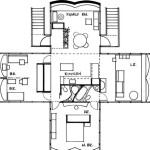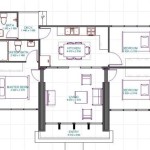Essential Aspects of Grid Paper For Floor Plans
Grid paper is a crucial tool for architects, interior designers, and anyone involved in creating floor plans. It provides a structured and accurate base upon which to sketch and develop designs, ensuring that measurements and proportions are precise.
When selecting grid paper for floor plans, several essential aspects should be considered:
Grid Spacing
The spacing of the grid lines determines the scale of the floor plan. Common grid spacings include 1/4 inch, 1/2 inch, and 1 inch, with the smaller spacings allowing for more detailed plans. The appropriate grid spacing depends on the complexity and scale of the floor plan.
Grid Type
There are two main types of grid paper: isometric and orthographic.
- Isometric Grids: These grids depict objects in three dimensions and are often used for creating perspective drawings.
- Orthographic Grids: These grids represent objects in two dimensions and are commonly used for creating floor plans and elevations.
Sheet Size
The size of the grid paper should accommodate the size and complexity of the floor plan. Smaller sheets are suitable for small-scale plans, while larger sheets provide more space for larger plans with intricate details.
Paper Quality
High-quality grid paper is resistant to tearing and smudging, ensuring that floor plans remain legible throughout the design process. Paper with a smooth surface allows for easy drawing and erasing.
Other Features
Some grid paper may include additional features, such as:
- Pre-printed Symbols: These symbols represent common architectural elements, such as walls, doors, and windows, saving time in drafting.
- Scale Bars: These markings indicate the scale of the floor plan, making it easy to determine exact measurements.
- Quadrant Markings: These markings divide the grid into quadrants, facilitating easy identification of specific areas within the floor plan.
Benefits of Using Grid Paper
Grid paper offers numerous benefits for floor plan creation, including:
- Accuracy and Precision: The grid lines ensure that measurements and proportions are accurate, reducing errors in design.
- Easy Scaling: Grid paper allows for easy scaling of floor plans, ensuring that they can be reproduced at different sizes without losing accuracy.
- Communication: Grid paper serves as a clear and universal language for conveying floor plan designs between architects, clients, and builders.
- Time-Saving: The structured layout of grid paper speeds up the drawing process, especially when pre-printed symbols are used.
By carefully considering the essential aspects of grid paper, architects and designers can select the most appropriate type and features to meet the specific requirements of their floor plan designs.

Printable Graph Paper Free Com

Ringel House Plan Graph Paper Second Floor Drawing Plans Design

Printable Graph Paper Free Com

Free Graph Paper Template Printable And Grid

Graph Paper To Virtual The Heardmont Floor Plan Welcome

How To Make An Old Fashioned Floor Plan With Graph Paper Dans Le Lakehouse

How To Draw A Floor Plan Scale Measuring Sketching

Printable Graph Paper Kitchen Design

A Super Simple Method For How To Draw Floor Plan Hampton Redesign

A Super Simple Method For How To Draw Floor Plan Hampton Redesign








